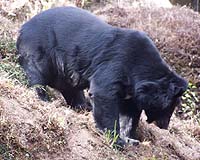| . |  |
. |
Santa Barbara CA (SPX) Sep 28, 2010 Sometimes, treasures can be found in your own backyard - especially if you know what to look for. This is what happened to Jeff Goddard, project scientist with the Marine Science Institute at UC Santa Barbara. Goddard was working in the tide pools at Carpinteria Reef, in Carpinteria State Park, Calif., when he found a new species of nudibranch - a group of sea slugs noted for their bright colors and delicate forms. Recognizing it as new, Goddard carefully documented the living specimen before preserving it and sending it off to Terrence M. Gosliner, an authority on the taxonomy of sea slugs at the California Academy of Sciences in San Francisco. Goddard kept the slug in his lab for a few days, until it laid an egg mass, and was also able to observe its early development and hatching larvae. Gosliner named the new sea slug after Goddard when he described it - and one other newly discovered species of California nudibranch - in the Sept. 15 online edition of the Proceedings of the California Academy of Sciences. "The shallow-water nudibranch fauna of Southern California especially is well known, so it was pretty exciting to find a new species right under our noses here in Santa Barbara County," said Goddard. "Only one specimen was found, so now we need to find out where more are hiding, what they feed on, and whom they interact with." Goddard said that he was honored that Gosliner chose to name the new species after him. The scientific name is Flabellina goddardi, and it measures about 30 millimeters long when stretched out and crawling. The genus Flabellina also includes the well-known "Spanish shawl" nudibranch, Flabellina iodinea. Goddardi is now the fifth species of Flabellina known from California. In the scientific article, Goslinger writes: "Flabellina goddardi is named for friend and colleague Jeff Goddard who found the only specimen of this distinctive species. Jeff is the consummate naturalist with superb powers of observation." For the scientific record, Goddard describes the new species as "characterized externally by its smooth rhinophores; long tail and cephalic tentacles; pointed foot corners; red and orange tipped cerata; and lack of pigmentation on the head, body and head tentacles." Goddard discovered the sea slug in 2008. As with many taxonomic discoveries, the finding often takes a couple of years for documentation, comparison with known species, and publication. Meanwhile Goddard and his colleagues will continue searching for more specimens of the newly described species.
Share This Article With Planet Earth
Related Links University of California - Santa Barbara Darwin Today At TerraDaily.com
 Reformed hunter battles to save Bangladesh's wildlife
Reformed hunter battles to save Bangladesh's wildlifeSrimongal, Bangladesh (AFP) Sept 27, 2010 Sitesh Ranjan Deb says his transformation from hunter to conservationist was triggered 20 years ago when he was attacked by a Himalayan black bear while out stalking deer. Sitesh, from northeastern Bangladesh, stumbled on the sleeping beast. It lashed out, severely damaging his face and one eye, and only emergency surgery saved his life. During many long months of recovery, Sitesh decide ... read more |
|
| The content herein, unless otherwise known to be public domain, are Copyright 1995-2010 - SpaceDaily. AFP and UPI Wire Stories are copyright Agence France-Presse and United Press International. ESA Portal Reports are copyright European Space Agency. All NASA sourced material is public domain. Additional copyrights may apply in whole or part to other bona fide parties. Advertising does not imply endorsement,agreement or approval of any opinions, statements or information provided by SpaceDaily on any Web page published or hosted by SpaceDaily. Privacy Statement |